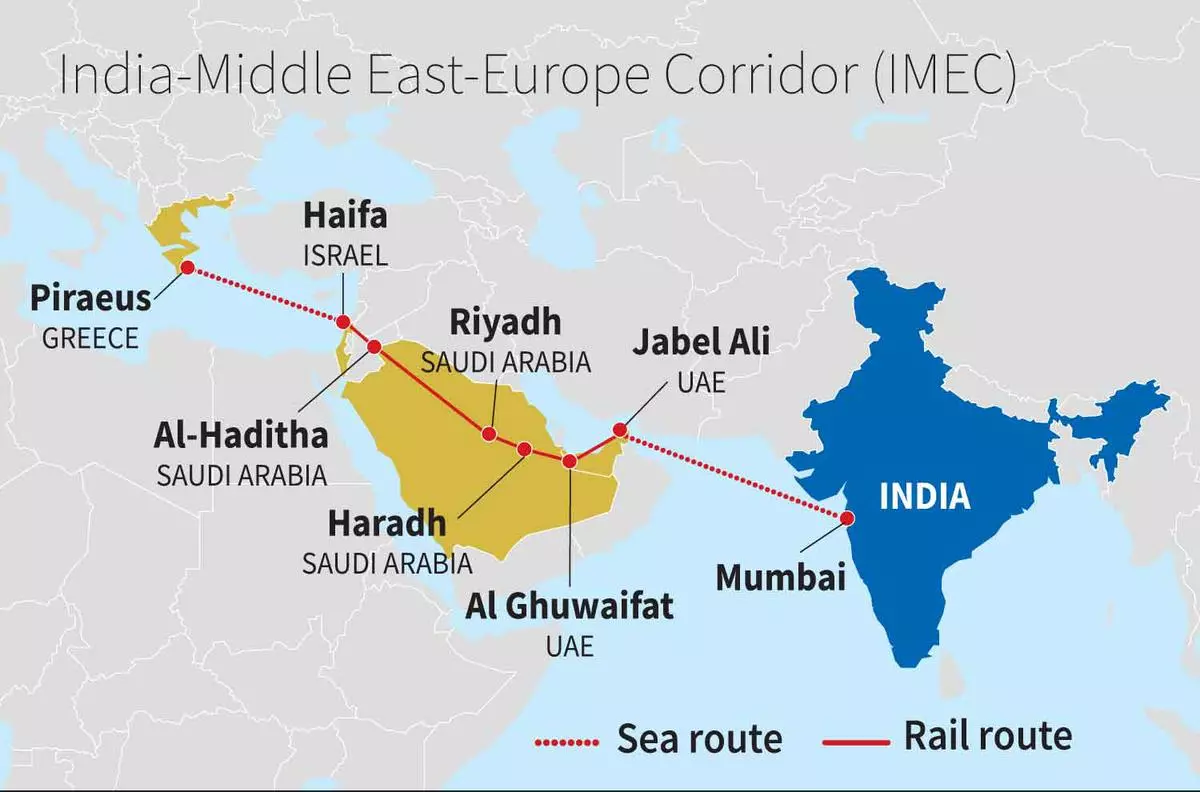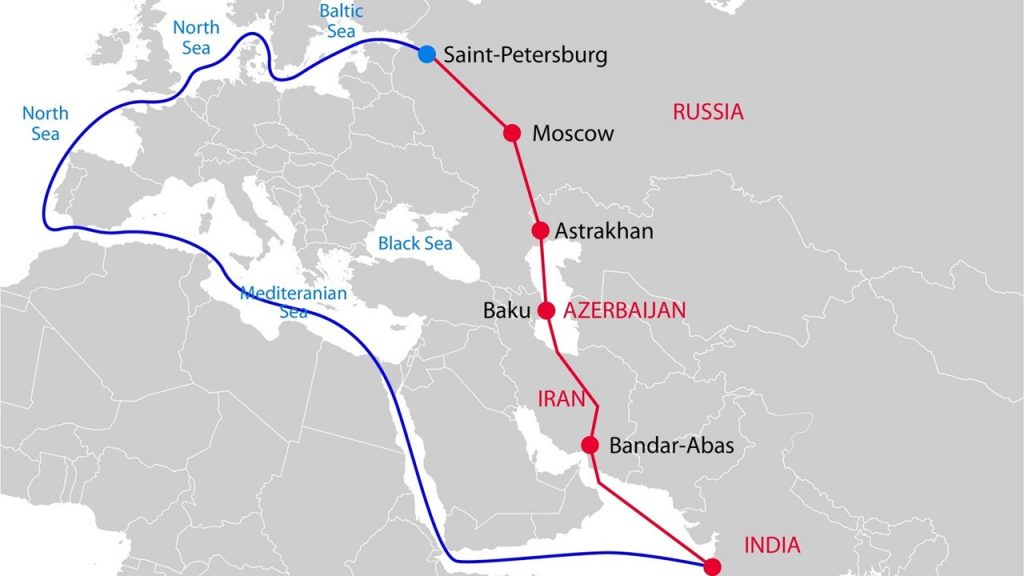
The recent announcement of the India-Middle East-Europe Economic Corridor (IMEC) during the New Delhi G20 summit has sparked excitement and intrigue. This ambitious multi-modal connectivity project aims to link India’s western coast with Europe, effectively offering an alternative to the Suez Canal through a railway network in the Middle East. While some may draw parallels with previous connectivity initiatives in India that struggled to materialize, IMEC appears to hold the promise of success. In fact, IMEC could play a pivotal role in supplementing and revitalizing India’s other global trade routes.
The Genesis of IMEC
The origins of IMEC can be traced back several years, stemming from the groundbreaking 2020 Abraham Accords that normalized relations between Israel and Arab states. This diplomatic milestone opened up the possibility of a strategic trade route through traditionally volatile regions in the Arabian Peninsula and the Levant. An August 2021 report by Prof. Michaël Tanchum emphasized the potential cost savings of up to 40% for an India-Europe trade route via this corridor compared to the traditional Suez Canal route.1 Subsequent discussions at the 12th Sir Bani Yas Forum in Dubai in November 2021, involving foreign ministers from multiple nations, underscored the growing interest and momentum behind this corridor.2 Recent geopolitical developments have only heightened the appeal of IMEC.
The Complex Landscape of INSTC

The International North–South Transport Corridor (INSTC) has encountered an array of intricate challenges since its inception in 2002. Originally designed to establish a trade route connecting India and Russia through Iran and Azerbaijan, INSTC’s geopolitical significance surged when China acquired the Baloch port of Gwadar as part of its expansive China-Pakistan Economic Corridor (CPEC) investments. India, in response, doubled down on their development efforts in the Iranian port of Chabahar as part of its involvement in the INSTC. This was seen as a counterbalance to China’s naval presence in Gwadar, although there were no indications of India having military rights over Chabahar.
One of the most pressing challenges confronting INSTC is the strained relationship between Iran and Azerbaijan, despite both countries having Shia-majority populations. Azerbaijan’s consistent support for Pakistan on the Kashmir issue, combined with India’s deepening defense collaboration with Armenia, has further complicated the progress of this corridor. While alternative routes through Armenia and Georgia have been explored, Georgia’s potential reluctance to host a trade route to Russia, a country with which it has had no formal ties since the 2008 war, presents significant hurdles.
In efforts to bypass these obstacles, the eastern branch of INSTC, encompassing a Kazakhstan-Turkmenistan-Iran rail corridor, has gained prominence.3 Additionally, the 2018 “Convention on the legal status of the Caspian Sea” has the potential to facilitate Iran-Russia trade through the territorial waters of Central Asian states, bypassing Baku.
Recent developments continue to impede INSTC’s progress. The significance of the Chabahar port for Indo-Afghan trade has waned following the Taliban’s takeover of Kabul. Sanctions imposed on both Iran and Russia have rendered INSTC a formidable challenge for India. Furthermore, the Ukrainian conflict has diminished the prospects of India’s access to Europe through Russia.
However, it is premature to dismiss INSTC altogether. Given the many naval chokepoints in the traditional India-Russia trade route, both INSTC and the Chennai–Vladivostok Maritime Corridor remain relevant. If India can continue to adeptly navigate its geopolitical positioning and effectively utilize both IMEC and INSTC in tandem, it stands to gain substantial advantages in the evolving global trade landscape.
On a side note, Russian President Vladimir Putin’s remarks welcoming IMEC while defending INSTC’s cost economics suggest that Russia still sees itself as a gateway for Indo-European trade.4 The European Union’s stance on this will be instrumental in determining INSTC’s future and scope.
Reviving the Asia-Africa Growth Corridor (AAGC)
In 2017, the announcement of the Asia-Africa Growth Corridor (AAGC) by India and Japan generated considerable excitement and garnered global attention. This ambitious initiative was viewed as a counterbalance to China’s Belt and Road Initiative (BRI) in the context of growing concerns about Chinese debt traps in Africa and other parts of the world. But fast forward 6 years and the project hasn’t come out of its vision document. As India increases its soft power in Africa by championing the Global South’s cause, it’s essential to complement this goodwill with tangible projects like the AAGC.
IMEC’s geographic proximity to Africa, particularly Northern Africa, provides a natural link between the two initiatives. This synergy has the potential to not only enhance the AAGC’s relevance and effectiveness but also revolutionize trade in Northern and Eastern Africa, unlocking economic opportunities and promoting regional integration.
Why IMEC is Poised for Success
IMEC benefits from several advantageous factors. The active interest of the United States in furthering Israel-Arab normalization, combined with India’s burgeoning relationships with progressive Arab states, provides a strong foundation for the project. India’s expertise in railways, coupled with financial resources from Arab nations, positions IMEC as a formidable initiative to fund and develop the necessary infrastructure. IMEC also promises to enhance supply chain efficiency and cost-effectiveness as the intermediate nations are trading powers in their own right. However, it remains to be seen how it will shape up against the BRI, or if it is even designed to do so.
In Conclusion
The success of IMEC holds immense importance for India, particularly in light of past stalled projects. Integrating IMEC with other initiatives is a complex endeavor requiring diplomatic finesse, but it’s a foundation worth laying. With the right approach, IMEC has the potential to reshape India’s connectivity landscape and position the nation as a pivotal player on the global trade stage.
-
“India’s Arab-Mediterranean Corridor: A Paradigm Shift in Strategic Connectivity to Europe”, Michaël Tanchum, South Asia Scan, Issue No. 14, Published by the Institute of South Asian Studies (Singapore), August 2021. ↩
-
“Plans afoot for connectivity from Mediterranean to India via Gulf”, Sidhant Sibal, WION, 5 October 2021. ↩
-
“Russia launches trade with India via Eastern branch of INSTC involving Central Asian states”, Dipanjan Roy Chaudhury, The Economic Times, 7 July 2022. ↩
-
“Putin welcomes India-ME-Europe Corridor but questions its feasibility”, Dev Kachari, The Economic Times, 14 September 2023. ↩